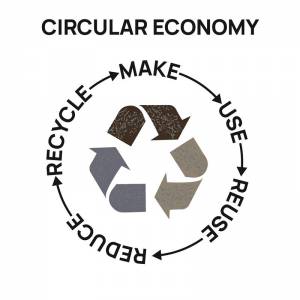The fashion industry, like its counterparts in other industries, has been using technology to meet its sustainability goals. Luxury brands like Prada, and fast-fashion ones like H&M, have been using ECONYL®, an innovative regenerated nylon material in their products. In an attempt to reduce the usage of plastic, H&M announced that it would be using recycled sequins as embellishments.

Fashion and Sustainability: How technology is revolutionizing the Fashion industry
From ‘Linear Fashion’ where traditionally virgin materials have been used for production of garments, the fashion industry is slowly moving towards ‘circular fashion,’ where the concept is recycle and reuse. In circular fashion, the monomers and polymers used in the manufacture of garments, are recycled using chemical, physical or mechanical processes.
While traditional recycling of post-consumer waste is an industry of its own, fashion companies have been partnering with technology companies to recycle cellulose, polyester etc. The success of monomer/polymer/fiber recycling will also depend on the type of source fiber. Asahi Kasei has been processing 100% cotton linter, the post-industrial residue of cotton processing, into Bemberg Cupro fiber (regenerated cellulose fibers). This process has been commercialized in Japan, and the plant capacity is ~17,000 mt per annum. In Switzerland, Gr3n has been developing a process for the manufacture of monomers starting from PET, using microwave radiation.
To achieve their sustainability goals, fashion companies have entered into many partnerships. Innovative bio-based vegan leather made from plant-based materials instead of petroleum-based leatherite is also rising in popularity. British designer Stella Mc Cartney has partnered with California-based mycelium start-up, Bolt Threads, to create the Frayme Mylo bag, made from mushroom leather. In India, Anita Dongre has been one of the first luxury designers to partner with Mirum®, a cruelty-free vegan leather alternative to create a line of bags and accessories from innovative plant-based and plastic-free materials.
Blockchain has been bringing transparency to fashion’s supply chains with tools that can inform customers about the entire journey of a product from sourcing to delivery (to the customer), and in what quality and condition. For fast-fashion brands and luxury brands, blockchain establishes authenticity of goods, beating the counterfeit market. Luxury houses LVMH, along with Prada & Cartier, have partnered to develop Aura Blockchain Consortium, which is the world’s first global luxury blockchain.
Interesting patents have been filed on textile recycling by many inventors / applicants. US10588369B2 from Oklahoma State University deals with upcycling of used textiles. It is related to a method that repurposes fabric by breaking down existing products and reassembling them in a unique manner, and upcycling used clothing to create new products. Existing textile products are deconstructed into pieces of fabric and then reassembled into apparel in a manner that creates minimal or zero waste.
Renewcell, based in Sweden, has developed Circulose®, a branded dissolving pulp that is made from 100% textile waste, such as worn-out jeans and production scraps. Fiber producers use man-made cellulosic fibers by dissolving pulp for making viscose, lyocell, modal, acetate and other such biodegradable fibers. Renewcell has a few patents, of which US11414789 deals with Cellulose fibers; US11618978 deals with recycling of cellulosic textiles, and US9751955 with regeneration of cellulose. It has been observed that when specially treated recycled textile is mixed together with cellulose-dissolving pulp, and then made into a fiber using the Viscose or the Lyocell process, an unexpected increase in the tensile strength of the resulting fiber occurs.
An interesting happening is that brands such as H&M, Intimissimi and Calzedonia, are inviting consumers to return their old clothes to them. This is in response to a specific regulatory framework in France. The regulations require manufacturers and distributors to collect and recycle as much of their end-of-life products as possible under environmentally friendly conditions. Another binding element for the textile industry in France is the draft law “La loi anti-gaspillage pour une économie circulaire” (Law against waste for a circular economy), which prohibits the destruction of unsold textiles by brands.
Zara, a fast-fashion company, has been making dresses from recycled Carbon emissions. Zara and LanzaTech have partnered to launch a limited line of black dresses made from carbon emissions. LanzaTech’s patented process captures and converts emissions from steel mills into Lanzanol (ethanol) using a fermentation process. The Lanzanol is then converted into low carbon monoethylene glycol by India Glycols Limited, which is then converted into low carbon polyester yarn. This yarn has been used to make fabric for a Zara capsule collection of party dresses.
Lululemon, another fashion company, has been working with many partners to address sustainability. Lululemon is in the process of creating plant-based nylon to replace the current use of synthetics in its products. It has partnered with Genomatica to convert plant-based ingredients into chemicals which in turn are used to make nylon. Interestingly, Lululemon Athletics too has partnered with LanzaTech, to create yarn and fabric using recycled carbon emissions.
With increasing focus on sustainability and circular economy, one can expect to see more action in the fashion industry.
Author
V. Anitha and Uma Parameswaran
